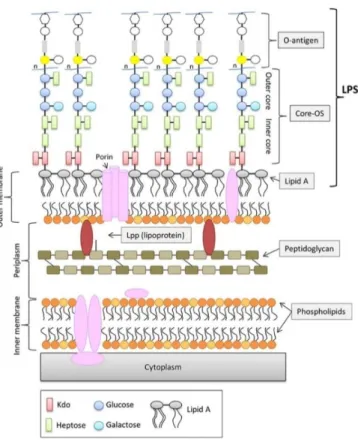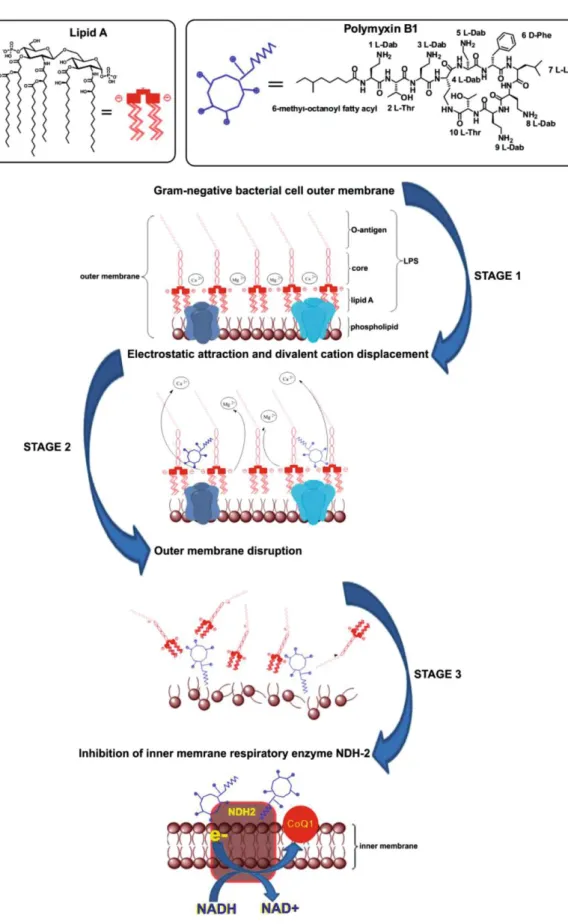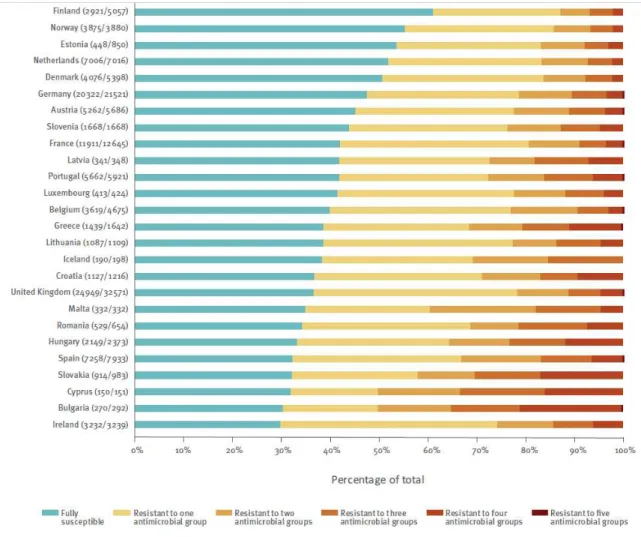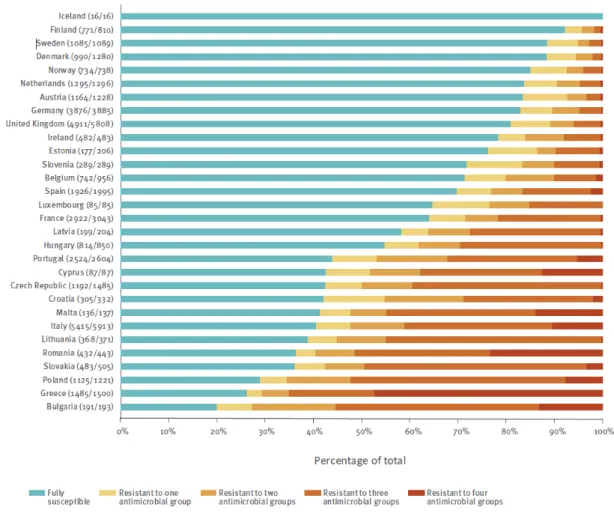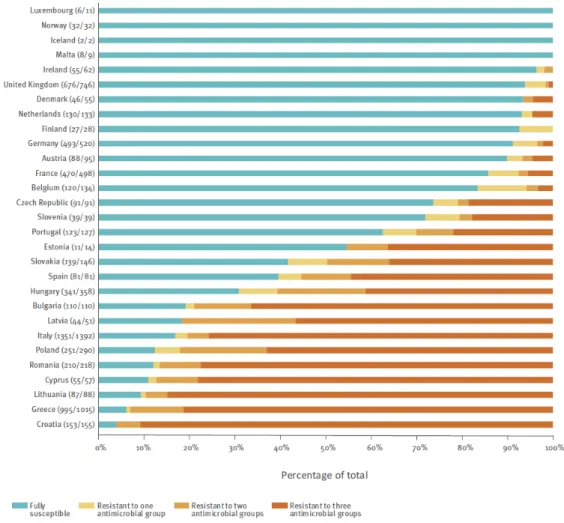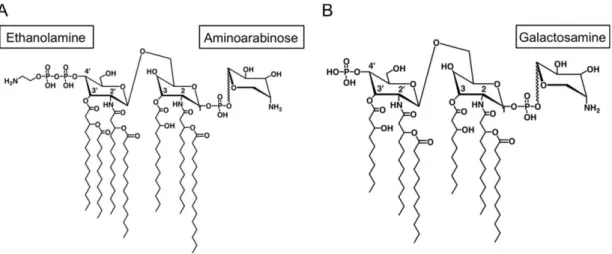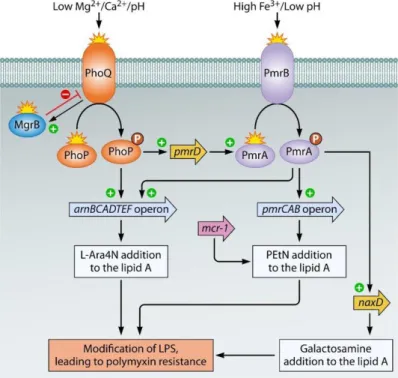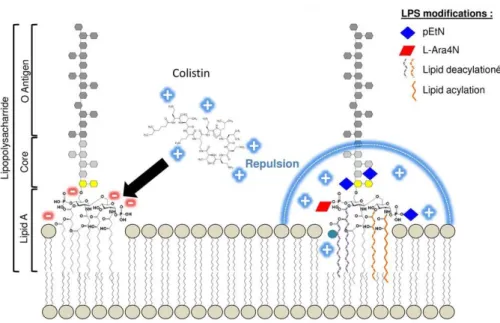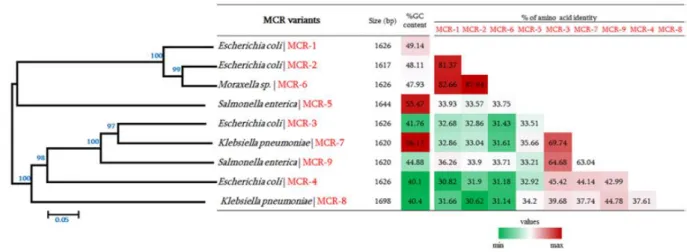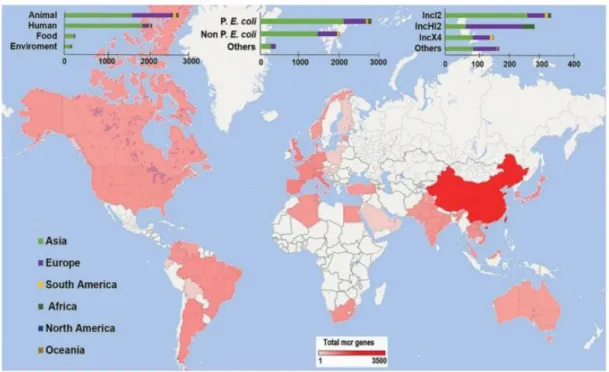THÈSE
Pour l'obtention du grade de
DOCTEUR DE L'UNIVERSITÉ DE POITIERS UFR de médecine et de pharmacie
Laboratoire pharmacologie des anti-infectieux (Poitiers) (Diplôme National - Arrêté du 25 mai 2016) École doctorale : Sciences Biologiques et Santé (Limoges) Secteur de recherche : Pharmacologie et sciences du médicament
Présentée par :
Hariyanto Ih
Mechanisms and PK/PD modelling of MCR-1-induced
adaptive resistance in Enterobacteriaceae
Directeur(s) de Thèse : William Couet, Julien Buyck
Soutenue le 18 décembre 2020 devant le jury Jury :
Président Sandrine Marchand Maître de conférences et praticien hospitalier, Université de Poitiers Rapporteur Françoise Van Bambeke Professeur, LDRI, Université Catholique, Louvain, Belgique
Rapporteur Jean-Winoc Decousser Professeur et praticien hospitalier, Université Paris-Est, Créteil Membre William Couet Professeur et praticien hospitalier, Université de Poitiers Membre Julien Buyck Maître de conférences, PHAR, Université de Poitiers
Membre Titik Nuryastuti Professeur, Universitas Gadjah Mada, Yogyakarta, Indonésie
Pour citer cette thèse :
Hariyanto Ih. Mechanisms and PK/PD modelling of MCR-1-induced adaptive resistance in Enterobacteriaceae [En ligne]. Thèse Pharmacologie et sciences du médicament. Poitiers : Université de Poitiers, 2020. Disponible sur
THESE
Pour l’obtention du Grade de
DOCTEUR DE L’UNIVERSITE DE POITIERS
(Faculté Médecine et Pharmacie)
(Diplôme National - Arrêté du 25 mai 2016)
Ecole Doctorale « Sciences Biologiques & Santé »
Secteur de Recherche : Pharmacologie et sciences du médicament
Présentée par:
Hariyanto IH
************************
Mechanisms and PK/PD modelling of MCR-1-induced
adaptive resistance in Enterobacteriaceae
************************
Directeur de Thèse :
Pr William COUET
Dr Julien M BUYCK
************************
Soutenue le 18 Décembre 2020
Devant la Commission d’Examen
************************
JURY
Pr Françoise VAN BAMBEKE, Université Catholique de Louvain (Belgique) Rapporteur
Pr Jean-Winoc DECOUSSER, Université Paris-Est Créteil
Rapporteur
Pr Titik NURYASTUTI, Universitas Gadjah Mada (Indonésie)
Examinateur
Pr Sandrine MARCHAND, Université de Poitiers
Examinateur
ACKNOWLEDGEMENT
I would like to express my deepest appreciation to my advisor Pr William COUET for his continuous support of my PhD program, for your guidance and your constructive criticism. He has been a great mentor in mapping my PhD journey and advising on a research topic. Thanks for giving me an opportunity to join research team INSERM U1070 and working under your supervision.
I would also like to extend my deepest gratitude to my co-advisor Dr Julien M BUYCK, for teaching me all about microbiology, his close supervision in biology molecular, for editing my thesis and for widening my research from various perspective. I am extremely grateful for your patience, motivation and your helpful advice. The completion of my dissertation would not have been possible without your helpful contribution.
My sincere gratitude goes to Pr Françoise VAN BAMBEKE and Pr Jean-Winoc DECOUSSER for accepting to be the evaluator my PhD thesis. I would also like to thank to Pr Titik NURYASTUTI honoring me as his presence in the jury of my thesis.
I would like to extend my sincere thanks to Pr Sandrine MARCHAND for her scientific support during my article writing, and for accepting to be president of jury of my thesis. I thank her for constant help during my study in the lab. Rigour and advice.
I also had great pleasure of working with all the members of the U 1070:
To Dr Nicolas GREGOIRE, for a great support during PK/PD modeling part of my thesis. To Dr Alexia CHAUZY, for helping me in the modeling part and answering my many stupid questions. It was a pleasure working with you.
To Dr Frederic TEWES, Dr Blandine RAMMAERT, and Dr Julien BRILLAULT for a great discussion and their precious advises.
To Eduardo, for your knowledge in PK/PD and for bearing several stupid questions regarding PK/PD
To Betty, for helping me during my first year in the lab. To Rana, Grace, Shachi, and Luc for their support and maintaining a good environment in our room.
To Jennifer, Romain, Kevin, Jérémy, Théo, Emma, Bruna, Muriel, Patrice, Julian, Christophe, Agnes, Helene, Isabelle, Etienne, Vincent, and all the members of the lab, for all the fun we have had in the last few years. Their warm welcome and good humor made those four years of thesis as the most enjoyable years.
To all my friends from Indonesian student association (PPI) of French and Poitiers, for the fun and their help during my stay in French.
A very special gratitude goes out to all down at Indonesian Endowment Fund for Education (LPDP) and BUDI-LN from ministry of finance and Directorate General of Higher Education of the Republic of Indonesia, for helping and providing the funding for the study and the research. Special thanks to Pr Gérard MAUCO, who gave me the golden opportunity to do my PhD.
I am forever grateful to my parents, my sisters, and all my family member in Indonesia, for their support and their encouragement which helped me in completion of this dissertation.
ABSTRACT
Due to the lack of new antibiotics facing the increasing emergence of resistances, it is important to understand the mechanism and dynamics of these phenomenon. Lipopolysaccharide (LPS) is the polymyxin main target and the most contributing component to polymyxin resistance. Plasmid-mediated colistin resistance MCR-1 (Mobile Colistin Resistance) carrying by Escherichia coli and Klebsiella pneumoniae encodes a phosphoethanolamine transferase leads to the addition of phosphoethanolamine to lipid A of LPS. However, chromosomally-encoded LPS-modifying phosphoethanolamine transferase and loss of LPS are the two primary mechanisms that have been described in colistin-resistant Acinetobacter baumannii to date. Polymyxin-resistance occurred during polymyxin treatment, but the mechanism and dynamics how these strains acquired resistance is poorly understood. Sequential time-kill (TK) were developed as an alternative approach to discriminate heterogenous subpopulations (S/R) versus adaptive resistance (AR) during colistin and polymyxin B exposure.
In this thesis we:
1. Confirm that sequential TK could discriminate between a single homogenous population of bacteria without or with adaptation (AR) and two independent subpopulations with different antibiotic susceptibilities (S/R) demonstrated by pharmacokinetics/pharmacodynamics (PK/PD) modelling.
2. Determine the molecular impact of MCR-1 in the progressive adaptation of E. coli and K. pneumoniae over chromosomal genes involved to LPS modification by using the sequential TK approach.
3. Determine the mechanisms involved in polymyxin resistance in two clinical strains of A. baumannii, isolated from a patient before and after treated with colistin. These studies not only provide a simple approach to discriminate between two PK/PD models, but also an indication that the MCR-1 presence favor another resistance mechanism leading to high-level resistance to polymyxin. By the similar approach, we determine how colistin-susceptible and resistant A. baumannii isolates respond under polymyxin pressure, including the genes involved. Furthermore, polymyxin B showed a lower capacity to induce high-level of resistance than colistin for all bacterial species. Keywords: colistin, polymyxin B, E. coli, K. pneumoniae, A. baumannii, sequential time-kill
RESUME
Caractérisation des mécanismes et modelling PK/PD de la
résistance adaptative induite par MCR-1 chez les
Enterobacteriaceae
Du fait du manque de nouveaux antibiotiques et de l’augmentation des résistances, il est important de comprendre les mécanismes et la dynamique de ces phénomènes. La modification du lipopolysaccharide (LPS) est le principal mécanisme contribuant à la résistance des bactéries aux polymyxines. Le plasmide portant le gène MCR-1 (Mobile Colistin Resistance) retrouvé chez Escherichia coli et Klebsiella pneumoniae code une phosphoethanolamine transférase capable de modifier le LPS par une addition de phosphoethanolamine sur le lipide A du LPS alors que chez Acinetobacter baumannii résistant aux polymyxines il a été décrit à la fois des modifications du LPS par une phosphoethanolamine et une perte du LPS. Cependant, les interactions entre les différents mécanismes exprimés par ces bactéries à Gram-négatif pour devenir résistantes à la colistine et à la polymyxine B sont encore peu décrit. Les courbes de bactéricidies séquentielles ont étés utilisées comme une approche alternative pour discriminer l’héterorésistance de la population bactérienne (2 sous populations S/R) d’une résistance adaptative (AR) durant le traitement par la colistine ou la polymyxine B.
Au cours de ce travail de thèse, nous avons :
1. Confirmé que l’approche des courbes de bactéricidies séquentielles peut discriminer trois modèles pharmacocinétique/pharmacodynamique (PK/PD) semi-mécanistiques décrivant : une population stable héterorésitante (S/R), une population bactérienne sans adaptation et une population bactérienne instable et homogène dont la résistance s’adapte au cours du temps (AR).
2. Déterminé l’impact de la présence du plasmide MCR-1 sur les mécanismes de résistance chromosomique impliqués dans la résistance adaptative de E. coli and K. pneumoniae aux polymyxines.
3. Déterminé les mécanismes impliqués dans la résistance aux polymyxines dans deux souches cliniques d’A. baumannii, isolées avant et après traitement d’un patient à la colistine.
Dans ce travail, une nouvelle approche de courbes de bactéricidies séquentielles a été utilisée et validée afin de pouvoir différencier différents modèles PK/PD
semi-mécanistiques. De plus, ce travail a montré que la présence du plasmide MCR-1 favorisait l’activation d’autres mécanismes chromosomiques conduisant à de hauts niveaux de résistances aux polymyxines. Enfin, la polymyxine B montrait une plus faible capacité à induire ces mécanismes chromosomiques conduisant à de hauts niveaux de résistance.
Mots clés : colistine, polymyxine B, E. coli, K. pneumoniae, A. baumannii, courbe de bactéricidies séquentielles
TABLE OF CONTENTS
Acknowledgement ... 3 Abstract ... 5 Résumé ... 6 List of Publications ... 10 List of Communications ... 11 List of Abbreviations ... 12 List of Figures ... 15 List of Tables... 16CHAPTER 1.GENERAL INTRODUCTION...17
Emergence of polymyxin resistance in Gram-negative bacteria ... 19
CHAPTER 2. LITERATURE REVIEW ...23
I. Polymyxins: The Arising of “Old” Class Antibiotics ... 25
1. Discovery of the family “polymyxin” ... 26
1.1. Colistin and polymyxin B ... 27
2. Mechanisms of action and antibacterial spectrum ... 30
2.1. Lipopolysaccharide structure of Gram-negative bacteria ... 30
2.2. Polymyxins: Mode of Action ... 32
2.3. Antibacterial spectrum ... 34
3. Antimicrobial susceptibility testing of polymyxins ... 35
3.1. Clinical breakpoints ... 36 4. Clinical use ... 38 4.1. Colistin ... 38 A.Commercial preparation ... 38 B.Clinical practice... 38 4.2. Polymyxin B... 39 A.Commercial preparation ... 39 B.Clinical practice... 40
II. Gram-negative Bacteria: Emergence of Multidrug Resistance Pathogen ... 43
1. Enterobacteriaceae ... 43
1.1. Pathogenic Escherichia coli ... 44
A.Epidemiology of E. coli infections ... 45
B.Antimicrobial resistance in E. coli ... 46
2.1. Klebsiella pneumoniae ... 48
A.Epidemiology of K. pneumoniae infections ... 49
2. Non-fermentative bacilli : Acinetobacter baumannii ... 54
2.1. Epidemiology of A. baumannii infections ... 55
2.2. Antimicrobial resistance in A. baumannii ... 56
III.Polymyxin Resistance in Gram-negative Bacteria ... 59
1. Chromosomally-mediated polymyxin resistance ... 60
1.1. Lipopolysaccharide-lipid A modification ... 60
A.Addition of of 4-amino-4-deoxy-L-arabinose (L-Ara4N) ... 64
B.Addition of phosphoethanolamine (PEtN) ... 65
C.Addition of galactosamine (GalN) ... 66
D.Other regulatory system ... 67
1.2. Loss of lipopolysaccharide ... 68
1.3. Capsule formation ... 70
1.4. Efflux in polymyxin resistance and outer membrane protein ... 70
1.5. Polymyxin-inactivating enzyme ... 71
1.6. Colistin heteroresistance ... 72
2. Plasmid-mediated colistin resistance ... 73
2.1. Description of mobilized colistin resistance (MCR) ... 73
2.2. Prevalence of mcr-1 ... 75
2.3. Structure of the mcr-1 gene and plasmid ... 76
2.4. Clinical impact and in vitro study of MCR-1 ... 79
IV.PK/PD of Antibiotics ... 81
1. MIC-based approaches ... 82
2. In vitro time-course-based approaches: Time-kill kinetic studies ... 83
2.1. Bacterial submodel (pharmacodynamic model) ... 83
2.2. Pharmacokinetic model ... 84
2.3. Pharmacokinetic-pharmacodynamic model ... 84
PROBLEMS AND OBJECTIVE OF THE STUDY ... 87
CHAPTER 3. EXPERIMENTAL WORK ...89
ARTICLE 1. SEQUENTIAL TIME-KILL STUDY TO DISCRIMINATE PK/PD MODEL ...91
ARTICLE 2. SEQUENTIAL TIME-KILL STUDY OF K. PNEUMONIAE WITH COLISTIN ...101
ARTICLE 3. STUDY OF E. COLI WITH COLISTIN AND POLYMYXIN B ...133
ARTICLE 4. ADAPTIVE RESISTANCE OF A. BAUMANNII TO COLISTIN AND POLYMYXIN B ...159
DISCUSSION AND PERSPECTIVE ... 191
LIST OF PUBLICATIONS
• Alexia Chauzy*, Hariyanto Ih*, Matthieu Jacobs, Sandrine Marchand, Nicolas Grégoire, William Couet, Julien M Buyck. 2020. Sequential time-kill: a simple experimental trick to discriminate between PK/PD models with distinct heterogenous sub-populations versus homogenous population with adaptive resistance. Antimicrobial agents and chemotherapy. 64 (8): e00788-20. DOI: 10.1128/AAC.00788-20.
*Alexia Chauzy and Hariyanto Ih contributed equally to this work and are listed in alphabetical order
•
Hariyanto Ih, Alexia Chauzy, Sandrine Marchand, Nicolas Grégoire, William Couet, Julien M Buyck. Pharmacodynamic modelling of sequential time-kill data exhibiting MCR-1 klebsiella pneumoniae adaptive resistance towards colistin with arn T gene overexpression. In submission•
Hariyanto Ih, Sandrine Marchand, Nicolas Grégoire, William Couet, Julien M Buyck.Characterization of lipopolysaccharide-modifying genes involved in polymyxin resistance in Escherichia coli carrying MCR-1 by sequential time-kill approach. In manuscript.
• Hariyanto Ih, Sandrine Marchand, Nicolas Grégoire, William Couet, Julien M Buyck. Sequential time-kill to distinguish polymyxin-induce resistance and heteroresistant in colistin-resistant Acinetobacter baumannii. In manuscript.
LIST OF COMMUNICATIONS
• ORAL presentation at the 30th European Congress of Clinical Microbiology and Infectious Diseases (ECCMID) | Paris | April 2020 - Sequential time-kill experiments to characterize lipopolysaccharide-modifying genes involved in polymyxin resistance in Escherichia coli and Klebsiella pneumoniae carrying MCR-1
Hariyanto Ih, Nicolas Grégoire, William Couet, Sandrine Marchand and Julien M Buyck.
• POSTER presentation at 30th European Congress of Clinical Microbiology and Infectious Diseases (ECCMID) | Paris | April 2020 - Sequential time-kill curve to distinguish polymyxin-induced resistance and heteroresistance in Acinetobacter baumannii.
Hariyanto Ih, Nicolas Grégoire, William Couet, Sandrine Marchand and Julien M Buyck.
• ORAL presentation at 39ème Réunion Interdisciplinaire de Chimiothérapie Anti-Infectieuse (RICAI) | Paris | December 2019 - Rôle de MCR-1 dans la résistance adaptative aux polymyxines.
Hariyanto Ih, Nicolas Grégoire, William Couet, Sandrine Marchand and Julien M Buyck.
• ORAL presentation at 15th Congrès National de la Société Française de Microbiologie (SFM) | Paris | October 2019 - Genetic characterization of lipopolysaccharide-modifying genes involved in polymyxin resistance in Escherichia coli and Klebsiella pneumoniae carrying MCR-1 by sequential time-kill experiments approach.
Hariyanto Ih, Nicolas Grégoire, William Couet and Julien M Buyck
• ORAL presentation at 10th International Seminar of Indonesian Society for Microbiology (10th ISISM) & 12th Congress of Indonesian Society for Microbiology (12th CISM) | Solo, Indonesia | August 2019 - Genetic characterization of lipopolysaccharide-modifying genes involved in polymyxin resistance in Escherichia coli and Klebsiella pneumoniae carrying MCR-1 by sequential time-kill experiments approach.
Hariyanto Ih, Nicolas Grégoire, William Couet and Julien M Buyck
• POSTER presentation at 29th European Congress of Clinical Microbiology and Infectious Diseases (ECCMID) | Amsterdam | April 2019 - Sequential time-kill experiments to characterize adaptative resistance to polymyxins in Gram-negative bacteria carrying MCR-1.
LIST OF ABBREVIATIONS
AMR : Antimicrobial resistance
ATP : Adenosine triphosphate
AUC : Area under the curve
CA-SFM : Comité de l’Antibiogramme - Société Française de Microbiologie
CFU : Colony-forming unit
cKp BLA
: :
Classical Klebsiella pneumoniae Beta-lactamase
Clcr : Creatinine clearance
CLSI : Clinical and Laboratory Standards Institute
CMS : Colistin methanesulphonate/ colistimethate sodium
CoQ1 : Coenzyme-Q1 or Ubiquinone-1
CPS : Capsule polysaccharide
Css,avg : Average drug concentration at steady state
Dab : Diaminobutyric acid
D-Leu : D-leucine
D-Phe : D-phenylalanine
ECDC : European Centre for Disease Prevention and Control
ECVs : Epidemiological cutoff values
EHEC : Enterohemorrhagic Escherichia coli
EPEC : Enteropathogenic Escherichia coli
ETEC : Enterotoxigenic Escherichia coli
E-test : Epsilometer test
EUCAST : European Committee on Antimicrobial Susceptibility Testing
ExPEC : Extraintestinal pathogenic E. coli
FAD : flavin adenine dinucleotide
GalN : Galactosamine
GNB : Gram-negative bacteria
HUS : Haemolytic uremic syndrome
HvKp : Hypervirulent Klebsiella pneumoniae
ICU : Intensive care unit
Ile : Isoleucine
ISO : International Organization for Standardization
IU : International units
IV : Intravenous
KDO : 2-keto-3-deoxyoctonoic acid
KPC : Klebsiella pneumoniae carbapenemase
L-Ara4N : 4-amino-4-deoxy-L-arabinose
LPS : Lipopolysaccharide
MALDI-TOF : Matrix-Assisted Laser Desorption Ionization-Time of Flight
MCR : Mobilized colistin resistance
MDR : Multi-drug resistance
MIC : Minimum inhibitory concentration
MS : Mass spectrometry
NADH : Nicotinamide adenine dinucleotide (NAD) + hydrogen (H)
NAG : N-acetyl glucosamine
NDH-2 : Type-II NADH Dehydrogenase
NH2 : Azanide
Nva : Norvaline
OECD : Organisation for Economic Co-operation and Development
OM : Outer membrane
OXA : Oxacillinase
PAPs : Population Analysis profiles
PEtN : Phosphoethanolamine
PK/PD/TD : Pharmacokinetics/ Pharmacodynamics/ Toxicodynamic
RT-qPCR : Quantitative reverse transcription-polymérase chain reaction
ST : Sequence type
STEAEC : Shiga toxin-producing enteroaggregative E. coli
TCS : Two-component system
Thr : Threonine
TK/ TKC : Time-Kill/ Time-Kill Curve
UDP : Uridine diphosphate
UPEC : Uropathogenic E. coli
UTIs : Urinary tract infections
Val : Valine
VIM : Verona integron-encoded metallo-β-lactamase
WHO : World health organization
LIST OF FIGURES
Figure 1. General schematic of the outer membrane of E. coli K-12 ... 30 Figure 2. Detailed structure of Lipid A from Escherichia coli ... 31 Figure 3. Lipid A and Polymyxin B structures and its likely-mode interaction with outer membrane ... 33 Figure 4. Priority pathogen list identified by WHO ... 44 Figure 5. Distribution of E. coli isolates fully susceptible and resistance to one or more antimicrobial groups in EU/EEA countries in 2018 ... 47 Figure 6. Distribution of K. pneumoniae isolates fully susceptible and resistance to one or more antimicrobial groups in EU/EEA countries in 2018 ... 52 Figure 7. Distribution of Acinetobacter species fully susceptible and resistance to one, two and three antimicrobial groups (fluoroquinolones, aminoglycosides and carbapenems) in EU/EEA countries in 2018 ... 57 Figure 8. Lipid A modification by the addition of phosphoethanolamine, aminoarabinose and/or galactosamine that lead to polymyxin resistance ... 61 Figure 9. Regulation pathways of LPS modifications involving PhoP/PhoQ and
PmrA/PmrB two-component system ... 62 Figure 10. Modification of lipid A causing resistance to polymyxin ... 66 Figure 11. General features of MCR variants including their phylogenetic relationship with other MCR ... 75 Figure 12. The prevalence of mobile colistin resistance (mcr) have been identified in various countries ... 76 Figure 13. 2,600-bp-long sequence of the mcr-1 cassette ... 77 Figure 14. Circular maps of four dominant groups plasmids harboring the mcr-1 gene ... 78 Figure 15. Schematic presentation of PK/PD modeling ... 81 Figure 16. Six different PD models to reflect PD models for antibiotics ... 86
LIST OF TABLES
Table 1. The chemical structures of polymyxin B and colistin (polymyxin E) ... 29
Table 2. Antibacterial spectrum of colistin and polymyxin B ... 34
Table 3. Polymyxin breakpoints according to the CLSI and EUCAST guidelines ... 36
Table 4. Estimation of hvKp proportion among K. pneumoniae infections ... 50
CHAPTER 1
GENERAL INTRODUCTION
EMERGENCE OF POLYMYXIN RESISTANCE IN
GRAM-NEGATIVE BACTERIA
Antibiotic resistance has become a major threat to public health today, both in world-wide and Europe region, and has been classified as one of the three greatest threat for human health (1). Throughout European countries, the prevalence of antibiotic resistance widely increases (2). Based on the data presented by European Antimicrobial Resistance Surveillance Network (EARS-Net), 33 000 deaths each year in Europe are caused by resistant pathogens, mostly negative bacteria (GNB) (3). Infections caused by Gram-negative bacteria are recognized to be the most difficult infections to treat because of their ability to develop additional resistance mechanisms over the intrinsic drug resistance (4). Combine resistance to several antibiotics continues to increase in some Gram-Negative bacteria (Escherichia coli, Pseudomonas aeruginosa, Acinetobacter baumannii, and Klebsiella pneumoniae), consequently reducing the available treatment options (5). The EU members collaborated to assess the situation related to this emerging multidrug resistance Gram-negative bacteria (MDR (-)) by adopted a new European One Health Action Plan against antimicrobial resistance (AMR), such as implementing national measures for the prudent use of antimicrobials, promoting collaborative research using EU funding and shaping the global agenda on AMR. (2).
A list of priority pathogens identified by World Health Organization (WHO) revealed carbapenem-resistant Gram-negative A. baumannii and Enterobacteriaceae, mainly E. coli and K. pneumoniae, as a first priority in urgent need for new treatment since the effective therapeutic options are rapidly lose their efficacy against life-threatening infections cause by these pathogens (6). Multidrug resistance in E. coli has become the major concern whereas this bacteria may cause diverse and serious disease, such as urinary tract infections and bacteremia, and acquired resistant to many antibiotics, including β-lactam,
carbapenems, aminoglycosides, and fluoroquinolones by accumulating specific resistance genes (7). Another major pathogen, K. pneumoniae which may cause serious hospital-acquired infections, such as bacteremia, urinary tract infections and pneumonia, is a first carbapenem-resistant was reported in Enterobacteriaceae and exhibits a resistance rate more than 50% in European countries to all broad spectrum of antimicrobial agents including beta-lactam, fluoroquinolones, third-generation cephalosporins and aminoglycosides (8). A. baumannii strains, an opportunistic pathogen associated bacteremia, pneumonia, meningitis and urinary tract infections, were reported resistant to multiple classes of antibiotics, including β-lactam, fluoroquinolones, tetracyclines, and aminoglycosides and has reached more than 70% in both OECD and non-OECD countries (9, 10). Worryingly, developing new antibiotics is less attractive for many large pharmaceutical companies. And most of the latest antibiotic found in the last 30 years like teixobactin, a peptide-like secondary metabolite, does not act against GNB (11). Thus, colistin and polymyxin B, polypeptide antibiotics belonging to the class of polymyxins, are reconsidered and expected to be the last resort to overcome these infections of multidrug resistant GNB (12, 13).
Colistin (also known as polymyxin E) and polymyxin B have a narrow antibacterial spectrum, mainly against common Gram-negative bacteria in which the bactericidal activity is mediated by their electrostatic-based interaction with the Lipid A component of lipopolysaccharides (LPS) (12). Since the early 2000s, polymyxins widely attracted clinical and research interest to ensure their optimum dosing and safety for the clinical uses due to their narrow therapeutic window (14). However, being increasingly used as a last-line clinical therapeutic option, the resistance rate of E. coli, K. pneumoniae, and A. baumannii to polymyxins has been pushed (7, 15). Lipopolysaccharides modification by the addition of 4-amino-4-deoxy-L-arabinose (L-Ara4N) and phosphoethanolamine (PEtN) in the lipid A is the most common resistance mechanisms developed by polymyxin-resistant Enterobacteriaceae, mainly E. coli and K. pneumoniae that decrease the net charge of lipid
A leading to decreased polymyxin affinity (16). Two-component systems (TCSs) involving PmrA/PmrB and PhoP/PhoQ have a role in these mechanisms wherein their activation is triggered by environmental stimuli and specific mutations, and subsequently, result in the alteration of LPS-modifying genes expression (17). Different from Enterobacteriaceae, non-fermentative bacilli A. baumannii provide two primary mechanisms in polymyxin resistance, including LPS modification by the alteration of lipid A and the complete loss of LPS as a result of inactivation of lipid A biosynthesis genes, lpxA, lpxC, and lpxD, lead to polymyxin resistance (18, 19).
For several years, polymyxin resistance has been known by the involving of chromosomal mutations but in 2015, Plasmid-mediated colistin resistance MCR-1 was firstly reported in China (20). Since strains containing MCR-1 isolated from human and animal have been detected all over the world (21). It was reported in E. coli study that mcr-1 gene not only mediated polymyxins resistance by encoded the expression of PEtN in lipid A, as its primary mechanism, but also disturb the biosynthesis and transport of efflux pump lipoprotein which involved in polymyxin resistance (22). However, molecular impact of MCR-1 presence to lipopolysaccharide modification genes regulated by two-component systems is poorly described.
CHAPTER 2
LITERATURE REVIEW
I. POLYMYXINS: The Arising of
“Old” Class Antibiotics
Polymyxins was approved for clinical use in the late 1950s and it is one of the primary classes of antibiotics with activity against most Gram-negative bacteria. The clinical use of colistin and polymyxin B was limited in 1970s due to their serious toxicity after parenteral administration, including nephrotoxicity and neurotoxicity. Between 1980s and 1990s its parenteral use was almost completely discontinued and they were then replaced by novel, more active and less toxic antimicrobial agent, such as aminoglycosides, quinolones and β-lactams (12, 13, 23). However, the increasing multidrug-resistant (MDR) Gram-negative pathogens together with the decrease of new antimicrobial agents in this last two decades has forced physician to reintroduce polymyxins antibiotics as a last-line therapeutic option against life-threatening infection (24, 25). As a consequence, since mid-1990s, colistin and polymyxin B are used as the last resort for the treatment of infections caused by carbapenem-resistant Enterobacteriaceae, Acinetobacter baumannii, and Pseudomonas aeruginosa that are resistant to all aminoglycosides, quinolones and β-lactams (14, 17). However, over the last 15 years, research and clinical interest to colistin and polymyxin B have increased and have attracted government and other public grant bodies to establish its preclinical and clinical research due to the increase of its use in clinical practice. Thus, to harmonize the information about its use, first international conference on polymyxins in Prato, Italy, in 2013 resulting ‘Prato Polymyxin Consensus’ was held, and subsequently maintained each year (26). Moreover, the international consensus guidelines for the optimal use of the polymyxins is finally available and published in 2019 showing a serious effort to optimize the clinical use of polymyxins (27).
1.
DISCOVERY OF THE FAMILY “POLYMYXIN”
The polymyxins is a cyclic lipopeptide antibiotic that was originally isolated in 1947 from the soil bacterium Paenibacillus polymyxa subsp. Colistinus (previously known as Bacillus polymyxa) concurrently by three different research group (28–30). First published in United States of America by Benedict and Langlykee in July 1947 and then in the same month by Stansly et al., they were describing a secondary metabolite compound isolated and purified from Paenibacillus polymyxa, an antimicrobial substance which they named as “Polymyxin”. They found that this compound on agar could inhibited the growth zone of Salmonella schottmuelleri that often cause paratyphoid fever in poor and rural communities across North America during 1930s. One month later in 1947, Ainsworth and co-workers from England had published their research about the identification of an antibiotic compound from the soil organism identified as Bacillus aerosporus that they called as “Aerosporin”. “Polymyxin” and “Aerosporin” had selective antibacterial activity with activity against Gram-negative bacteria, and furthermore, later publication in a year after had identified that these two compounds showing the similar basic peptide (31). Subsequently, further research to identify the pharmacological properties and microbial activity of both compounds had described that the antibiotic called “Aerosporin” and “Polymyxin” had a similar antibacterial spectrum and biological activity. It was concluded that these two antibiotics belonged to the same class of antimicrobial compounds (32, 33).
A consensus had reached by an international agreement that for all antibiotics derived from Paenibacillus polymyxa was named as Polymyxin (34). Consequently, “Aerosporin” was renamed as polymyxin A and “Polymyxin” was renamed as polymyxin D. Moreover, during this period other polymyxins isolated from same Paenibacillus polymyxa were characterized as polymyxin B, polymyxin C, and polymyxin E (also known as Colistin) (35). Although each polymyxin group has similar chemical structures and show similar antimicrobial activity, they exhibited striking differences in their cell toxicity. It was performed
that polymyxin A, C and D showed severe reversible nephrotoxicity, while polymyxin B and polymyxin E (colistin) were less toxic after in vivo examination in dog and rabbit (36). Generally, the polymyxin toxicity is associated by their N-terminal faty acyl segment (37). Further studies were performed then several reports had explained indicating the less renal injury were shown by colistin and polymyxin B among five polymyxins groups, and likely, this is a reason of only colistin and polymyxin B were available and preferably adopted in clinical practice until present (36, 38).
1.1. COLISTIN AND POLYMYXIN B
All polymyxins from each group were generelized by their similar pentacationic polypeptides structures like ilustrated in Table 1, which are consisting of a cyclic heptapeptide amide-linked loop between the amino group of the side chain of diaminobutyric acid (Dab) residue at position 4 and carboxyl group of the C-terminal threonine residue, a linear tripeptide and a fatty acid tail linked to normal N-terminal of the tripeptide (14). Polymyxin B is generally defined by the presence of D-phenylalanine residue at position 6, L-leucine residue at position 7 and L-Dab residue at position 3 (Table 1). To date, seven individual polymyxin B components have been identified with polymyxin B1 and polymyxin B2 are
always the major lipopeptide components with two minor components form the same “group” in its commercial formulations and the total of these major components content should be not less than 80% (39–41).
Interestingly with colistin, when it was firstly described, colistin was considered as a different entity from polymyxin antibiotics (42), until further chemical investigating determined that it has very similar structure with polymyxin E and it was concluded that they were a same compound (43). Colistin differ from polymyxin B in the amino acid component where the presence of phenylalanine residue at position 6 of polymyxin B is replaced by D-leucine in colistin (Table 1). To date, 11 individual colistin components have been
identified, and like polymyxin B, colistin consists of multicomponent with colistin A (polymyxin E1) and colistin B (polymyxin E2) are the major lipopeptide (44). It must
constitute ≥77% of the total content of colistin A and colistin B together with three other minor components according to the British (BP) and European Pharmacopeias (Ph. Eur.). Either colistin or polymyxin B are natural products prepared by fermentation, so the proportion from each component can vary from each brand and even among the batches from the same manufacturer. The commercial formulations differ between polymyxin B and colistin will be discussed in detail in “clinical use” part, include their impacts on in vivo disposition.
Overall, polymyxins are molecules that contain rich of hydrophobic part and hydrophilic parts make them as amphipathic compounds.
• Hydrophobic and hydrophilic domains were separated by exo-cyclic linear tripeptide sequence and cyclic ring heptapeptide giving these molecules as amphipathic structure that important for its antimicrobial activity.
• Dab residues (NH2) carrying positive charged of polymyxin as hydrophilic part of polymyxin will bind to negative charged phosphate group of lipid A outer membrane and the hydrophobic part of polymyxins, N-terminal fatty acyl group and hydrophobic residues (position 6 or 7), will make an hydrophobic contacts with fatty-acyl chains of lipid A.
• These interactions will destabilized the Gram-negative bacteria outer membrane leading to the lysis of bacteria cells (45). Furthermore, this mechanism will be further detailed in the part of ‘mechanism of action’.
• Not only accounted for its antimicrobial activity, but also the hydrophobic properties of the N-terminal fatty acyl group are presumably as the source of the nephrotoxicity of polymyxin (13, 46).
Table 1. The chemical structures of polymyxin B and colistin (polymyxin E) (adapted from Velkov et al., 2013 (14) ).
Polymyxin Fatty acyl group Pos. 6 Pos. 7
Polymyxin B B1 (S)-6-methyloctanoyl D-Phe Leu
B1 - Ile (S)-6-methyloctanoyl D-Phe Ile
B2 6-methylheptanoyl D-Phe Leu
B3 Octanoyl D-Phe Leu
B4 Heptanoyl D-Phe Leu
B5 Nonanoyl D-Phe Leu
B6 3-hydroxy-6-methyloctanoyl D-Phe Leu
Colistin/ polymyxin E
E1 (S)-6-methyloctanoyl D-Leu Leu
E1 - Ile (S)-6-methyloctanoyl D-Leu Ile
E1 - Val (S)-6-methyloctanoyl D-Leu Val
E1 - Nva (S)-6-methyloctanoyl D-Leu Nva
E2 6-methylheptanoyl D-Leu Leu
E2 - Ile 6-methylheptanoyl D-Leu Ile
E2 - Val 6-methylheptanoyl D-Leu Val
E3 Octanoyl D-Leu Leu
E4 Heptanoyl D-Leu Leu
E7 7-methyloctanoyl D-Leu Leu
E8 - Ile 7-methylnonanoyl D-Leu Ile
2. MECHANISMS OF ACTION AND ANTIBACTERIAL SPECTRUM
2.1. LIPOPOLYSACCHARIDE STRUCTURE OF GRAM-NEGATIVE BACTERIA
Different from Gram-positive bacteria, the cell envelope of Gram-negative bacteria (GNB) consists of the inner membrane, peptidoglycan, and are surrounded by an additional membrane, named outer membrane (OM) (Fig. 1). The outer membrane of Gram-negative bacteria play an important role to protect them from the external substances, including antimicrobial agents, whereas polyanionic lipopolysaccharide (LPS) of the outer membrane has an important role to regulate the compounds permeability (47). The Lipopolysaccharide molecule are divided into three parts, such as O-antigen, core polysaccharides and a hydrophobic component referred to as lipid A.
Figure 1. General schematic of the outer membrane of E. coli K-12 (adapted from Ebbensgaard et al., 2018 (48) ).
Lipopolysaccharide, the major compound in the outer membrane are important for the bacteria survival where their detailed structure could differ from one bacterial species to another and even could be different in the same bacterial species, which is given by their genetic information, but consistent for their basic structure (49). O-antigen repeats (O polysaccharide) are displayed on the surface of bacterial cells that made of a chain from several types of repeating sugar and act as hydrophilic polysaccharide (48, 49). Second part of LPS is core polysaccharide or core-R-antigen which consists of short chain of sugar, including glucose, galactose, heptose and 2-keto-3-deoxyoctonoic acid (KDO). Heptose and KDO are two unusual sugars and are usually present in the core oligosaccharide so it has been used as well as an indicator in LPS assays (50). The third part, lipid A, is the lipid part of LPS and bind to core polysaccharide via six position of N-acetyl glucosamine (NAG) of lipid A. Lipid A consists of a phosphorylated NAG dimer with 6 or 7 saturated fatty acid attached. In contrast to the O-antigen, Lipid A structure is highly conserved among GNB (48). As a major part to stabilize outer membrane structure, lipid A has role as main part of LPS endotoxin activity as well and recognized as a pathogen-associated molecule by immune-cells systems (49).
Figure 2. Detailed structure of Lipid A from Escherichia coli (adapted from Steimle et al., 2016 (51) ).
2.2. POLYMYXINS: Mode of Action
Lipid A has a key role in polymyxins antimicrobial action by their charged-based interaction. Dab residues (NH2) carrying positive charged as hydrophilic part of polymyxin will bind to negative charged phosphate group of lipid A outer membrane, while the hydrophobic part of polymyxins, N-terminal fatty-acyl group and hydrophobic residues (position 6 / 7) will make a hydrophobic contact with fatty-acyl chains of lipid A. These electrostatic and hydrophobic binding combination will produce a strong interaction between polymyxin molecule and LPS by forming an envelope-like fold conformation (45). Furthermore, the positive charge of polymyxin will displace the
membrane-stabilizing magnesium (Mg2+) and calcium (Ca2+) ions, which are
important as a stabilizer for the outer membrane by bridging the adjacent lipid A molecules. Displacing of these divalent cations will have an impact on destabilization of the outer membrane, increase cell permeability, leakage of cell-contents, lysis cell, and finally, bacterial cell death (45, 52–54). Bacteria cells lysis has a consequence at risk producing amount of endotoxins causing-fever agents and it was reported that colistin has a potent action to inhibit it by neutralizing the endotoxin (52).
The outer membrane is not the only target of polymyxins. As we can see in Figure 3, secondary mode of action involved in their bactericidal activity is the ability to inhibit of bacterial respiration. Based on available evidence, colistin and polymyxin B could inhibit NDH-2, a type II NADH-quinone oxidoreductases. It was suggested that the N-terminal fatty acyl chain and the positive charges of the polymyxin molecule are playing an important role for NDH-2 inhibitory activity (45, 55). NDH-2 in inner membrane of bacteria cells contains a non-covalently bound flavin adenine dinucleotide (FAD) prosthetic group and catalyzes the oxidation of NADH to NAD+ coupled to reduction of quinone, which plays
Figure 3. Lipid A and Polymyxin B structures and its likely-mode interaction with outer membrane
2.3. ANTIBACTERIAL SPECTRUM
The structural similarities between colistin and polymyxin B are given by both compounds, many aspects, such as clinical uses, toxicity, mode of action, and antimicrobial spectrum activity are shared by both as well (58). For antimicrobial activity, they exhibit a narrow antibacterial spectrum, mainly against common Gram-negative bacteria.
Table 2. Antibacterial spectrum of colistin and polymyxin B (adapted from Li et al., 2019 (12) ).
Enterobacteria-ceae Non-fermentative GNB Others Mycobacterium Susceptible E. coli, K. pneumoniae, Citrobacter spp., Enterobacter spp., Salmonella spp., Shigella spp. Acinetobacter baumannii, Pseudomonas aeruginosa, Stenotrophomonas maltophilia Haemophilus spp., Bordetella pertussis, Legionella spp., Aeromonas species (except Ae. Jandaei) M. xenopi M. intracellulare M. tuberculosis M. fortuitum M. phlei M. smegmatis Resistant Proteus spp., Providentia spp., Serratia spp., Brucella spp. Burkholderia cepacia complex, P. pseudomallei, Moraxella catarrhalis,
Gram-positive bacteria, Vibrio spp., Morganella morganii, Helicobacter pylori, Neisseria spp. (meningococci and gonococci), Edwardsiella tarda.
3. ANTIMICROBIAL SUSCEPTIBILITY TESTING OF
POLYMYXINS
Several studies have been published related to MIC distribution of colistin and polymyxin B against E. coli, K. pneumoniae, A. baumannii and P. aeruginosa by variety of method, including Etest® and agar dilution (60–62). Later, MIC determination for colistin and
polymyxin B by disk diffusion methods was not recommended after a comparative study showing that disk diffusion testing methods failed to reliably detect polymyxin-resistant strains in clinical isolates of Acinetobacter spp, Pseudomonas aeruginosa, and Enterobacteriaceae (63, 64). Indeed, polymyxins as a polypeptide antibiotics have a difficulty to diffuse in agar resulting in small zones of inhibition (63). Although, a variety of studies exhibited a good result for the gradient diffusion test, such as E-test method (65– 67), several studies revealed that this method failed to detect the resistance to the polymyxins of clinical carbapenem-resistant isolates of A. baumannii and Enterobacteriaceae (68). Likely with agar diffusion, this problem might be due to the polymyxin difficulty to diffuse in agar.
A joint working group was established by Clinical and Laboratory Standards Institute (CLSI) and European Committee on Antimicrobial Susceptibility Testing (EUCAST) to recommend the most appropriate MIC determination regarding by several methodological issues of in vitro susceptibility testing in polymyxins. The issues have been comprehensively investigated and it was agreed that ISO-Standard broth microdilution method (20776-1) is the best reference testing for Enterobacteriaceae, Acinetobacter spp., and Pseudomonas aeruginosa (64).
3.1. CLINICAL BREAKPOINTS
If a standard reference method has already been established, there is no consensus between these two professional organizations related to colistin and polymyxin B breakpoints. Before 2019, only P. aeruginosa and A. baumannii colistin and polymyxin B MIC breakpoints with no interpretive criteria for Enterobacteriaceae were provided by CLSI, which is only epidemiological cutoff values (ECVs) were used as clinical breakpoints. After a pharmacokinetic/ pharmacodynamic (PK/PD) review, outcomes and MIC distribution data, breakpoints for colistin and polymyxin B are available for Enterobacteriaceae, P. aeruginosa and A. baumannii but no interpretative criteria for polymyxin B in EUCAST guideline (69, 70). But based on breakpoints recommendations of la Société Française de Microbiologie
(French Microbiology Society), interpretative criteria for polymyxin B were available based on colistin data (71). Only intermediate and resistant without susceptible category was suggested in CLSI guideline regarding to the limited clinical efficacy of colistin and polymyxin B even for isolates with MIC values <2 mg/L based on the clinical and PK/PD recommendation (further detail will be explained in “clinical use” part).
Table 3. Polymyxin breakpoints according to the CLSI and EUCAST guidelines
Microorganisms Polymyxin
CLSI 1 CA-SFM/ EUCAST 2 MIC breakpoint (mg/L) 3 MIC breakpoint (mg/L) 3
S I R S I R Enterobacteriaceae Polymyxin B - ≤2 ≥4 ≤2 - >2 Colistin - ≤2 ≥4 ≤2 - >2 Acinetobacter spp. Polymyxin B - ≤2 ≥4 ≤2 - >2 Colistin - ≤2 ≥4 ≤2 - >2 Pseudomonas spp. Polymyxin B - ≤2 ≥4 ≤2 - >2 Colistin - ≤2 ≥4 ≤2 - >2
1Clinical and Laboratory Standards Institute, 2019 (69)
2 Société Française de Microbiologieand European Committee on Antimicrobial Susceptibility Testing, 2020 (71) 3 S, susceptible; I, intermediate; R, resistant; -, not determined
Broth microdilution method was agreed as a standard reference method with following notes (64):
• Cation-adjusted Mueller-Hinton Broth as the reference media
• No additives may be included (including polysorbate-80 or other surfactants) • Trays must be made of plain polystyrene
• Sulphate salts of polymyxins must be used since an inactive prodrug of methanesulfonate derivative of colistin breaks down slowly in solution.
4. CLINICAL USE
4.1. COLISTIN
A. COMMERCIAL PREPARATION
At first introduction into clinical practice, colistin was commercially offered as a greater or equal antibacterial potency compared to polymyxin B but less toxic as its sulphomethylated derivative, sodium colistin methanesulphonate (CMS, colistimethate sodium, sodium colistimethate, penta-sodium colistimethanesulphate, sulphomethyl colistin) (58). A common problem of polypeptide compounds is an induction of site painful irritation during subcutaneous or intramuscular injection that could be overcomed by sulphomethylated derivatives, which firstly introduced by Stansly and his co-worker in 1947. Sulphomethylation of colistin was firstly applied by Koyama in 1957 and still administered intravenously in the clinic until now (12, 72). Commercially, colistin is available in two forms, colistin sulphate (hereafter referred to as colistin) and colistin methanesulfonate (CMS).
B. CLINICAL PRACTICE
Colistin is widely used as intravenous formulations as CMS, an inactive prodrug, to treat infections caused by MDR and extensively drug resistant (XDR) Gram-negative pathogens (27). CMS can be administered intramuscularly although is not commonly used in clinical practice regarding to its severe pain at the injection site and its variable absorption (12). Colistin has also been formulated for oral administration route for selective intestinal infection and is used as topical administration for bacterial skin, eye and ear infections (12). However, colistin and its prodrug CMS are the only polymyxins approved for clinical use in the European countries based on the completes review of polymyxins-based medicine by European Medicines Agency (73).
Compare to polymyxin B, CMS is preferred to treat urinary tract infection, because the conversion to colistin from its prodrug mostly in the urinary tract, but as consequently has a potential risk to renal injury as well (74). In addition, Intravenous CMS is indicated for the treatment of serious infections due to aerobic Gram-negative bacteria in patients with limited treatment options while inhalation of CMS is limited to chronic pulmonary infections due to P. aeruginosa with cystic fibrosis in adults with recommend dose is 1 to 2 million IU given 2 to 3 times a day and children 0.5 to 1 million IU twice daily (73).
A target plasma colistin Css,avg of 2 mg/L for systemic administration of CMS was
recommended based on three considerations (75). First, it based on colistin binding in plasma which is around 50%. Second, to achieve its bactericidal activity with an MIC of 2 mg/L against an isolate on the thigh infection model. And third, both risk incidence and severity of acute kidney injury (AKI) are increased for concentration greater than 2 mg/L (27). Finally, to achieve this desired target average steady-state plasma concentration, determining the initial daily maintenance dose is required, and subsequently, monitoring creatinine clearance (Clcr) and daily dose adjustment are also required (27).
4.2. POLYMYXIN B
A. COMMERCIAL PREPARATION
Polymyxin B is commercially available as polymyxin B sulphate and not indicated for oral use and likewise. No sulphomethylated derivative of polymyxin B is available in clinical use. Like we explained in the previous chapter, sulphomethylated derivative of polymyxins are required to reduce the pain of injection site cause by lipopeptide agents. In 1961, the sodium salt of sulphomethylated derivative of polymyxin B has been used intramuscularly and intraventricularly in 5 patients with P. aeruginosa secondary meningitis infection. It was found as well that no toxicity observed, and all five patients cured (76). However, this derivative has never been applied into clinical practice until present for unknown reason
(Kwa et al., 2007). Polymyxin B is not prepared as a prodrug. In clinical use, polymyxin B sulphate can be used as intramuscular, intravenous, inhalation, intrathecal and topical routes preparations (58).
B. CLINICAL PRACTICE
Like colistin, polymyxin B is available to treat infections cause by MDR and XDR Gram-negative bacteria by intravenous administration as the most often use in clinical (77). Intramuscular route is rarely used since it may cause local pain and not appropriate in polymyxin B nowadays. This antimicrobial is less active against lung infection but preferable used in invasive infections for routine systemic use regarding it shown an excellent PK profile compare to colistin with lower risk to cause nephrotoxicity (27). As a background, pharmacokinetic/ pharmacodynamic/ toxicodynamic (PK/PD/TD) of polymyxin B has never been defined before since it was firstly discovered. A very similar structure and antimicrobial spectrum shared by colistin and polymyxin B have made a conclusion that they have similar pharmacokinetic profile. The study always focused on CMS, the prodrug of colistin, and its result cannot be extrapolated as polymyxin B result whereas polymyxin B is administered as its active compound. Furthermore, a further study has found that polymyxin B exhibited a superior PK characteristic compare to CMS where it is reliable and rapidly achievable to maintain a desired concentration in human plasma, which is important for critically ill patients (27).
The risk of renal injury is less found in polymyxin B compare to colistin and this is a potential advantage for its clinical use over CMS (78). No need dose adjustment of polymyxin B for the patient with renal impairment because this drug is not eliminated in the kidneys, and in addition, a clinical PK studies show that polymyxin B clearance does not depend on creatinine clearance (Clcr). Moreover, a large clinical study was started in 2016
and first result estimate publish in 20201. This is a first study about PK/PD/TD profiles of IV
Polymyxin B on patients with pneumonia and/or bloodstream infection.
• Overall, colistin and polymyxin B exhibit an indistinguishable in vitro PD activity with identical potencies of antibacterial spectrum against MDR and XDR Gram-negative pathogens as shown by their MICs
• In vitro and murine thigh and lung infection models have been used to elucidate the PK/PD index of colistin while the available data for polymyxin B are fewer even rare. Free-drug area under the concentration-time curve to MIC ratio (fAUC:MIC) is the best PK/PD index to determine antibacterial activity, showing a higher tolerated systemic dose of polymyxin B is needed to obtain 1 log10 bacterial killing
compare to colistin (27). The highest tolerated dose of polymyxin B to obtain 2 log10 reduction in bacterial count was not achieved whereas it can be achieved by
colistin with the dose still appropriate to reach Css,avg of 2 mg/L as a target
plasma of colistin (27).
• In contrast in human, polymyxin B shown an excellent PK characteristic compare to colistin, since polymyxin B is administered as its active compound with lower risk to cause nephrotoxicity although CMS is preferred to treat urinary tract infection because the conversion to colistin from its prodrug mostly in the urinary tract (27).
As a recommendation, clinicians should have access to these both parenteral products so they can choose the better option in any particular circumstances.
II. GRAM-NEGATIVE BACTERIA: Emergence of Multidrug
Resistance Pathogen
Antimicrobial resistance is the ability of a microorganism to resist the action of one or more antimicrobial agents (5). Each year, more than 670.000 infections due to bacteria with antimicrobial resistance occur in European Union countries causing 33.000 deaths and costs abouts 1.1 billion euros for the health care systems of European countries (79). A list of priority pathogens identified by WHO revealed that carbapenem-resistant Gram-negative Acinetobacter baumannii and Enterobacteriaceae, mainly Escherichia coli and Klebsiella pneumoniae, as a first priority in urgent need for new treatment since the effective therapeutic options are rapidly lose their efficacy against life-threatening infections cause by these pathogens (Fig. 4) (5, 6).
P. aeruginosa, A. baumannii, K. pneumoniae and E. coli are the most common GNB that may cause healthcare-acquired infections and they may develop resistance to almost classes of antibiotics by multiple mechanisms (11). In this part, we focused on two Gram-negative Enterobacteriaceae, particularly E. coli and K. pneumoniae, and a non-fermentative bacillus isolate, A. baumannii.
1. ENTEROBACTERIACEAE
E. coli and K. pneumoniae are by far the most common Enterobacteriaceae that can cause both hospital- and community-acquired infections (3). Resistance percentages were generally higher in K. pneumoniae than in E. coli, and moreover, the emergence of carbapenems-resistant Enterobacteriaceae and Extended-spectrum-β-lactamase (ESBL)-producing Enterobacteriaceae are rising over the last decade thereby classified them as the pathogen that urgent and serious to treat (80, 81). In this part we detailed more about
pathogenic E. coli and K. pneumoniae, including the epidemiology and their resistance to several antimicrobial agents.
*Enterobacteriaceae include: K. pneumoniae, E. coli, Enterobacter spp., Serratia spp., Proteus spp., and Providencia spp.,
Morganella spp.
Figure 4. Priority pathogen list identified by WHO for new antibiotic research and development (World Health Organization, 2017 (6) ).
1.1. PATHOGENIC ESCHERICHIA COLI
First identified in 1885, Escherichia coli has become one of the most bacterial species that comprehensively studied. They are easy to grow and easy to manipulate in the laboratory scale, such as genetic manipulation, and naturally acquired mobile genetic elements (82, 83). Apart from their beneficial as flora normal for human and animal intestine, some E. coli
strains have evolved pathogenic mechanisms and may cause the disease in human and animal as well (82, 83). Habitat and genetic exchange are the primary reasons why E. coli can progress to many different forms of disease symptoms and outcome (83). Virulence factors and secreted protease, that are differently produced from one strain to another and are crucial determinants for the progression of these bacteria to cause a wide variety of disease (84). Based on their infection site, pathogenic E. coli are determined into two group, namely enteric or intestinal pathogenic E. coli that may cause diarroghenic syndrome or other intestinal disease, and extraintestinal pathogenic E. coli (ExPEC) as a causes of extraintestinal disease, such as urinary tract infection (UTI), haemolytic uremic syndrome (HUS) and meningitis (82–85).
A. EPIDEMIOLOGY OF E. COLI INFECTIONS
E. coli is one of Gram-negative bacteria that might cause nosocomial infections. They cause 12-50% of hospital-acquired infections and associated with 4% cases of diarrheagenic syndrome. In United States, E. coli is the primary cause of both community-acquired acquired and nosocomial urinary tract infection (UTI) with up to 50% prevalence mostly in female because of the urinary tract anatomical structure difference with male (85, 86), while in tropical countries, EPEC is the leading cause of childhood diarrhea (86). ETEC is the most common pathogen that cause traveler’s diarrhea for the visitors in several developing countries (86). Neonatal meningitis-causing E. coli cause 8% mortality rate and most of the survivors have developed neurological complications and septicemia associated with E. coli has similar mortality and morbidity rate same as with aerobic Gram-negative bacilli (86). In Europe, E. coli outbreaks were mostly caused by EHEC (87). STEAEC strains were reported mostly in Central Europe and responsible for Germany outbreak during 2011 with more than 900 of HUS. Urinary tract infections caused by MDR UPEC strains have been Increased in Europe, with the most prevalence cases are Spain and Italy (87).
In France, an epidemiological studies of carbapenemase-producing E. coli shown that most carbapenem resistant strains were found in urine samples (67.9%), followed by blood, bile and wound samples at 7.5%, 7.5% and 5.6%, respectively (88). Among the 140 studied isolates collected from Paris and suburbs, the Northeast of France and the southeast of France, 74.3% of isolates produced an OXA-48-like carbapenemase which are categorized as susceptible to imipenem according to EUCAST breakpoints but still controversial for in vivo results (88). The other isolates produced class B metallo-β-lactamases, NDM-type (20.7%) and VIM-type (3.6), and KPC-3 carbapenemase (0.7%). Fifty different sequence types (STs) have been identified from the total isolates showing a large diversity of these carbapenemase-producing E. coli isolates (88). However, all isolates susceptible to colistin (100%) and only 95% and 96% of the isolates are susceptible to Fosfomycin and nitrofurantoin, respectively (88). Among carbapenemase-producing E. coli cases, OXA-48-producing K. pneumoniae was found, suggesting an in vivo transfer in patient’s gut and support the previous findings that dissemination across diversified species among Enterobacteriaceae is possible (88). Among Enterobacteriaceae isolates, E. coli remains the second most common strains producing carbapenemase (31.5%) behind K. pneumoniae (38.5%) (88).
B. ANTIMICROBIAL RESISTANCE IN E. COLI
Broad spectrum antimicrobial agents are recommended and often used to treat community- and hospital-acquired infections cause by E. coli, such as β-lactams (particularly third generation cephalosporins), fluoroquinolones, aminoglycosides and trimethoprim-sulfamethoxazole, although nitrofurantoin and fosfomycin are used in several countries where the failure rate of fluoroquinolone treatments is high (89, 90). But since late 1990s the emergence of antibiotic resistance is on rise, the management of therapy is becoming complicated (3, 90). This species has an ability to accumulate genes encoding resistance, mostly through horizontal gene transfer. It was reported that the acquisition of genes
encoding extended-spectrum β-lactamases (resistance to broad-spectrum cephalosporins), plasmid-mediated quinolone resistance (resistance to fluoroquinolone), 16S rRNA methylases (resistance to aminoglycoside) and an increasing threat is carbapenemases, which may confer resistance to carbapenems and all available β-lactam antibiotics (3, 7, 90). Furthermore, the ability of Enterobacteriaceae to spread these resistance genes via cross-transfer of plasmid between inter-species and between animal and human made it worse to play a role in emergence of multidrug GNB.
Figure 5. Distribution of E. coli isolates fully susceptible and resistance to one or more antimicrobial groups in EU/EEA countries in 2018 declared by European Centre for
Figure 5 reported E. coli resistance in European countries between 2015-2018 over five antimicrobial group under regular surveillance, including aminopenicillins, fluoroquinolones, third-generation cephalosporins, aminoglycosides and carbapenems. Over than half (58.3%) of E. coli isolates were resistant to at least one antibiotic family with the highest percentage is aminopenicillins (57.4%) followed by fluoroquinolones, third-generation cephalosporins, and aminoglycosides at 25.3%, 15.1% and 11.1%, respectively, while carbapenems resistance remains rare. Higher resistance percentages generally reported from southern and eastern Europe. More than half E. coli infections in European countries were caused by antimicrobial-resistant E. coli with large inter-country variations in the use of broad-spectrum antimicrobials (3).
2.1. KLEBSIELLA PNEUMONIAE
First described in 1882, Klebsiella pneumoniae was a species isolated from the lungs of patients who died from pneumoniae (91). Similar with E. coli, this species is considered as commensal and opportunistic pathogen that is widely found in the mouth, skin and intestine. K. pneumoniae is the third leading cause of hospital-acquired infection (HAIs) since it is often found in hospital setting and medical devices as well (92). Furthermore, K. pneumoniae can be found in urinary tract, respiratory tract and blood causing UTIs, pneumoniae and bloodstream infections (91–93). In most case, K. pneumoniae infections occur during hospitalized or in patients with immunocompromised (94).
Colonization of gastrointestinal tract is an important reservoir for K. pneumoniae in healthcare-associated infections (95, 96). Disease-associated immunosuppression have been identified as another risk factor for community- and hospital-acquired infection of K.
pneumoniae such as cancer, diabetes mellitus and alcoholism (97–99). Electrolyte and fluid disorder, neurologic disorder, and prior hospital admission have been identified as well as risk factor associated with hospital-acquired infection (96).
K. pneumoniae employs several virulence factors (VFs) for survival, mostly on their surface structure, and in evading the host immune defense during infection, such as capsule polysaccharide, lipopolysaccharide, outer membrane protein (OmpA and OmpK36), and the efflux pump AcrAB (91, 92). LPS variations have been found that play a role in the emergence of K. pneumoniae resistance to antimicrobial peptide such as polymyxin antibiotic that will be further detailed in the chapter 3 of “polymyxins resistance” (100). The emergence of hypervirulent K. pneumoniae (hvKp) infections are on rise at last 3 decades (91, 101). hvKp is an evolving pathotype of classical K. pneumoniae (cKp) and more virulent (101). Clinicians are familiar with cKp as an opportunistic pathogen but hvKp is the best describe as a virulent pathogen.
A. EPIDEMIOLOGY OF K. PNEUMONIAE INFECTIONS
Klebsiella pneumonia is the third leading cause of hospital-acquired infections after Clostridium difficile and Staphylococcus aureus in the United States (9.9%) and the third cause of hospital-acquired pneumonia for ICUs patients receiving ventilator after 48 hours hospitalized, still in the same country (102). This species is also the second leading cause of bloodstream infection with mortality rate around 20-30% or 1.3 per 100,000 people in US (93, 102). UTI is the most common infection caused by K. pneumoniae either associated with diabetes mellitus or catheter-associated UTIs (103). K. pneumoniae was also reported to be responsible for 13% of wound/surgical site infections (102).
The prevalence of Kp infections in Western countries range from 5-35%, while in Asian countries were various from 18% to 87.7% in stool from health adults (95, 104). Nasopharyngeal colonized by K. pneumoniae in healthy humans are 1-5% in western
